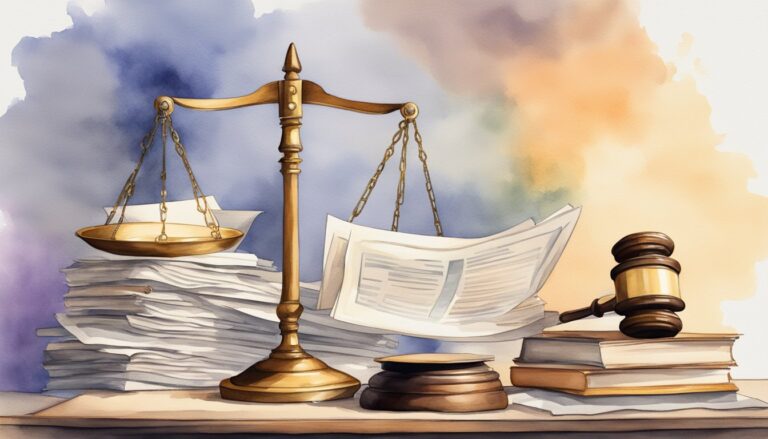Understanding Liability
Liabilities play a critical role in the financial health of an insurance company.
They represent obligations that impact how a business operates and plans for the future, influencing both short-term and long-term strategies.
Definition and Concepts
A liability is a company’s financial debt or obligation that arises during business operations.
Unlike assets, which are valuable resources owned by a company, liabilities are the amounts owed to others.
These obligations can be legal liabilities, such as those arising from lawsuits, or financial liabilities, including debts and contingent liabilities.
In the insurance industry, liabilities can also include accrued expenses and debts related to claims.
Understanding liabilities is essential for assessing a company’s financial risk and stability.
Assessing your liabilities helps in determining the capital structure and predicting future financial performance.
Types and Forms
Liabilities come in several forms and can be categorized based on their time frames. Current liabilities are obligations due within a year, such as accrued expenses or short-term debts.
These are critical for managing day-to-day operations and risk assessment.
Long-term liabilities, also known as non-current liabilities, are obligations that are due after a year.
These include long-term debt like bonds and mortgages.
In the insurance sector, policies with long-term claims fall into this category.
There are also specialized forms of liability like contractual liability, which arises from contractual agreements. Financial liabilities can include various forms of debt that an insurance company takes on to finance its operations, while contingent liabilities come into play based on specific events, such as potential lawsuits.
Managing these liabilities effectively ensures that an insurance company remains solvent and capable of fulfilling its obligations.
Examples of Liability in Practice
Liability in the insurance industry involves numerous practical applications, including various case studies and real-world examples.
These illustrations help to understand how liability concepts are implemented.
Case Studies
In one notable case, a food company faced legal action after customers became ill due to contaminated products.
The company had to pay significant sums to cover medical expenses and settlements.
This instance highlights the importance of having liability insurance to manage unexpected expenses.
Another case involved a large retail corporation sued by an employee for wrongful termination.
The employee claimed discrimination and unfair dismissal.
The court ruled in favor of the employee, resulting in substantial payouts for damages and attorney fees.
This demonstrates the need for businesses to have comprehensive policies to protect against such lawsuits.
Smaller incidents, like property damage caused by faulty products, also illustrate liability in practice.
A manufacturer of household appliances had to compensate customers and handle replacement costs for defective units.
Liability insurance often covers such claims, preventing significant financial losses.
Real-World Applications
Liability insurance plays a vital role in protecting your business from financial losses.
For instance, it covers claims related to employment practices, such as discrimination or wrongful dismissal.
Companies use employment practices liability insurance to safeguard against these claims and potential lawsuits.
In the real estate sector, landlords often purchase liability insurance to protect against injuries occurring on their properties.
If a tenant or visitor gets hurt due to unsafe conditions, the insurance covers medical costs and legal fees.
This helps property owners manage risks effectively.
Similarly, professional services like accounting and consulting firms use liability insurance to protect against claims of negligence or errors.
If a client suffers financial losses due to your advice, liability insurance mitigates the fallout, covering the legal expenses and any settlements.
These real-world applications underline the importance of understanding and applying liability insurance in various contexts to prevent significant pecuniary obligations.
Related Terms

Understanding related terms to liability can help you navigate the insurance world more efficiently.
This section covers important concepts and how to distinguish between them.
Similar Concepts
Economic benefits refer to the financial advantages you receive from your assets, as opposed to your liabilities. Non-current liabilities include long-term financial obligations such as bonds payable or mortgage payable.
These are not expected to be settled within a year.
Liability insurance protects you from claims resulting from injuries and damage to people or property. Contractual liability refers to obligations agreed upon in a contract, while absolute liability imposes responsibility without needing proof of fault.
Contingent liabilities are potential liabilities that may occur, depending on the outcome of a future event, such as a lawsuit. Deferred revenue is money received by a company for services yet to be performed or goods yet to be delivered, thus considered a liability until fulfilled.
Distinguishing Between Terms
Income tax liabilities are obligations to pay taxes on earned income. Tax liabilities can also include other types of taxes like sales tax. Pension liabilities are the retirement benefits owed to employees, calculated based on the amount of work and salary.
Long-term debt and non-current liabilities are often used interchangeably but differ slightly.
Long-term debt encompasses loans and financial obligations lasting over a year, while non-current liabilities include all long-term debts and other obligations like statutory redundancy payments.
Interest payable is the interest expense owed but not yet paid.
This is usually part of your company’s long-term debt obligations. Mortgage payable is another long-term liability, indicating the amount owed on a mortgage loan.
Hindrance and negligence can lead to financial liabilities if they cause injury to employees or damage to property.
Frequently Asked Questions

This section addresses common queries about liability in the context of the insurance industry, covering definitions, types, impacts, and recordings of liabilities.
What does liability mean in a legal context?
In legal terms, liability refers to responsibility for one’s actions or omissions.
This can result in being legally obligated to settle a debt or pay for damages caused by those actions.
How do liabilities differ from assets in financial accounting?
Liabilities are debts or obligations that a company must pay in the future, while assets are resources owned by the company that provide future economic benefits.
No company can accurately assess its financial health without considering both.
What are the different types of liabilities recognized in corporate finance?
Corporate finance recognizes various liabilities, including current liabilities like accounts payable, and long-term liabilities such as loans and mortgages.
Each type of liability has specific characteristics and impacts on a company’s financial statements.
In what ways can an individual be considered a liability?
An individual can be a liability if they pose a risk of loss or harm in a given context.
For instance, an employee could be a liability if their actions lead to legal or financial repercussions for the company.
Can you explain the concept of contingent liabilities and how they are recorded?
Contingent liabilities are potential obligations that depend on the outcome of future events.
They are recorded when the likelihood of the event is probable and the amount can be reasonably estimated, impacting a company’s financial planning and risk assessment.
How do liabilities impact a company’s financial health and balance sheet?
Liabilities affect a company’s balance sheet by indicating what the company owes.
High levels of liabilities compared to assets can signal financial instability.
Conversely, manageable liabilities can support growth and investment opportunities.
Proper accounting practices, like an umbrella policy, help manage these risks.






